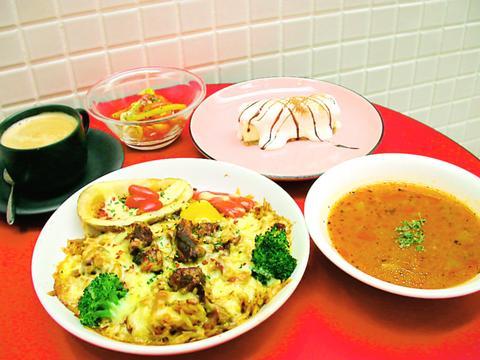New customers looking at Finocchio's limited space and low priced meals could be forgiven for thinking it's just another of those run-of-the-mill pasta chains where they can fit in a quick lunch. Contrary to its appearance, however, the pasta restaurant provides items of an authentic Italian flavor that you rarely come across in budget diners.
Finocchio's owner/chef set up the small restaurant as a distraction from his work as an interior designer. With no pressure to turn a profit, he has set prices much lower than average.

PHOTO: VICO LEE, TAIPEI TIMES
The interior of the restaurant, though small, is comfortably set up in delicious shades of red and cream colors.
"Our boss learned the pasta recipes from friends [who were cooks] that he met during his travels in the Italian countryside, so that although he has never attended a school of cuisine, he knows many recipes which even chefs in upscale hotels here do not know of," said Wu Mo-chen (吳默真), Finocchio's manager.
There are dozens of pastas on the menu. Each is prepared with sauces which are handmade each morning from ingredients handpicked at the market and spices imported from Italy.
Despite trying to provide authentic Italian flavor, the restaurant does turn down the potency a bit to cater to the local palate. Generous servings and friendly waitressing also helps keep the restaurant constantly busy during lunch hours. Even on weekday afternoons, there's a quite a flow of customers.
As Finocchio's major clientele are the nearby office workers mindful of their growing belly pouch, the restaurant avoids using too much oil, heavy cheese or gravy in its sauces. Baked items do away with excessive cream to create a light taste.
The shrimp sauce in spicy shrimp mostaccioli (NT$160) is made with a lot more than shrimps. It takes hours of frying, baking and boiling to turn the lobster head and a variety of fish and shrimps into the pleasantly sharp red-colored sauce.
Orzo is relatively rare in pasta houses, but Finocchio keeps it in ample supply. Wu recommended orzo with stewed beef, tomato sauce and baked potato (NT$160). A crisp cheese topping complements the refreshingly spicy sauce and pasta.
Bacon and mushroom pasta with yolk cream (NT$120) is not uncommon but in Finocchio, it can be served spicy. The small amount of chili pepper brings out the aroma of the cream. to best complement other ingredients.

Nov. 11 to Nov. 17 People may call Taipei a “living hell for pedestrians,” but back in the 1960s and 1970s, citizens were even discouraged from crossing major roads on foot. And there weren’t crosswalks or pedestrian signals at busy intersections. A 1978 editorial in the China Times (中國時報) reflected the government’s car-centric attitude: “Pedestrians too often risk their lives to compete with vehicles over road use instead of using an overpass. If they get hit by a car, who can they blame?” Taipei’s car traffic was growing exponentially during the 1960s, and along with it the frequency of accidents. The policy

Hourglass-shaped sex toys casually glide along a conveyor belt through an airy new store in Tokyo, the latest attempt by Japanese manufacturer Tenga to sell adult products without the shame that is often attached. At first glance it’s not even obvious that the sleek, colorful products on display are Japan’s favorite sex toys for men, but the store has drawn a stream of couples and tourists since opening this year. “Its openness surprised me,” said customer Masafumi Kawasaki, 45, “and made me a bit embarrassed that I’d had a ‘naughty’ image” of the company. I might have thought this was some kind

What first caught my eye when I entered the 921 Earthquake Museum was a yellow band running at an angle across the floor toward a pile of exposed soil. This marks the line where, in the early morning hours of Sept. 21, 1999, a massive magnitude 7.3 earthquake raised the earth over two meters along one side of the Chelungpu Fault (車籠埔斷層). The museum’s first gallery, named after this fault, takes visitors on a journey along its length, from the spot right in front of them, where the uplift is visible in the exposed soil, all the way to the farthest

The room glows vibrant pink, the floor flooded with hundreds of tiny pink marbles. As I approach the two chairs and a plush baroque sofa of matching fuchsia, what at first appears to be a scene of domestic bliss reveals itself to be anything but as gnarled metal nails and sharp spikes protrude from the cushions. An eerie cutout of a woman recoils into the armrest. This mixed-media installation captures generations of female anguish in Yun Suknam’s native South Korea, reflecting her observations and lived experience of the subjugated and serviceable housewife. The marbles are the mother’s sweat and tears,